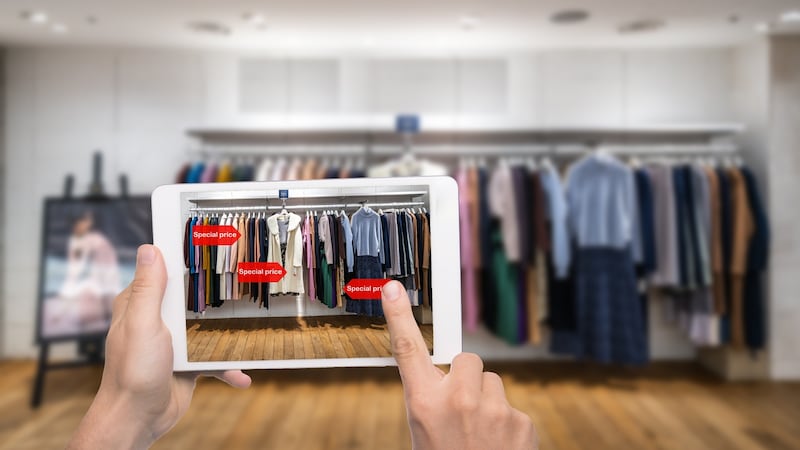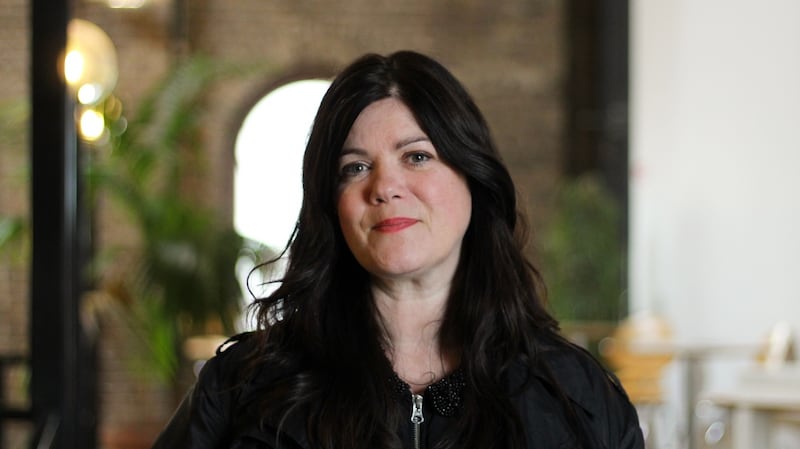The clothes we wear reflect the lives we lead and the times we live in, so these are strange, unnerving times in fashion. In the past cataclysmic year of the pandemic, the $1.5 trillion (€1.252 trillion) global fashion industry has been shaken to its core, with stores closing, supply chains disrupted and sales collapsing or moving online as all of Europe went into lockdown and mountains of surplus collections remained unsold.
So what will our sartorial choices be like when restrictions are lifted? What will we want to wear? How will we want clothes to make us feel?
Ecommerce (data-driven online shopping) may dictate our choices rather than bricks and mortar outlets. Of this, more later.

Without customary social interactions – from the everyday school drop-off to visiting friends and relatives, or holidays abroad, concerts and attending funerals and weddings – the way we dress and what we buy has also changed. Comfort and ease have become priorities when housebound or exercising outdoors, and with so many working from home, tabletop dress codes (and backgrounds) become considerations for video conferencing. We certainly got hairier and greyer.
According to the world's most respected fashion forecaster, Li Edelkoort, as we come out of this phase, "we will be aching for something new to refresh our personalities – eccentric clothes, romantic clothes," she told the New York Times. We may not need any more leggings, sweatpants and tracksuits, uniforms that may become associated with isolation, loneliness and curtailed human interactions.
Creativity
Times of crisis, however, also generate creativity – as we’ve seen throughout history. For instance, Dior’s voluminous skirts and tiny waists of the New Look in 1947 after the second World War were a direct response to the utilitarian uniforms and scarcity of the wartime years, releasing long pent-up desires.
But the first thing we do know is that we can’t go back to the way things were. By 2020, the fashion industry needed to change: Too much was being manufactured, it was a treadmill for designers, an unstoppable juggernaut, and its effect on the environment was untenable and unsustainable. If you wanted to know what the latest fashion colour was, you only had to look at Chinese rivers and lakes: some 70 per cent are contaminated by wastewater from the textile industry.
Environmentalists and activists regularly point to the cost of fast fashion and overproduction. There is the ongoing scandal of landfill: in 2018, long before Covid closed the high street, retail giant H&M reported a stock mountain of $4.3 billion (€3.59 billion) of unsold clothing. I remember being in the Kenyan slum of Kibera, the biggest in Africa, and witnessing at first hand the tower blocks of used clothing in the markets, a shocking sight.
Current ecommerce trends in both high-end and street fashion include recycling, lending, buying and selling apps and websites
The luxury retailer Burberry hit the headlines in 2017 for burning almost €33 million worth of unsold clothing, accessories and perfume. The backlash forced the company to halt such activities.
In future they say they will donate to charities or recycle. Big brands can also shift unsold stock in cut-price shops or outlets. Surplus stock at Marks & Spencer, for instance, is sold through sales, outlet centres and charity partners Oxfam, Newlife or SmartWorks to be reused or recycled. Primark, when forced to close, warehoused seasonal summer favourites that don't date.
While online shopping thrived during lockdown – Boohoo.com profits soared to over £800 million (€921 million) in September 2020, up 45 per cent on the same period in 2019, while Asos reported a 23 per cent increase in sales in a six-month period in 2020 – just shy of £2 billion (€2.3 billion) – there is also the problem of returns: 30 per cent of clothing and shoes bought online are returned, compared to 5 to 10 per cent of what is purchased instore, another headache for retailers that leads to unsold stock, and one of the factors that has discouraged Primark from selling online.

Repurposing
But things appear to be changing. Current ecommerce trends in both high-end and street fashion include recycling, lending, buying and selling apps and websites, and reusing or repurposing discarded garments.
Gabriela Hearst (who made Jill Biden's outfit for her husband Joe's inauguration as the 46th US president earlier this year) used secondhand versions of bags and leftover materials for her debut at Chloë in Paris, while the Renewal Workshop in Amsterdam is helping big brands such as Tommy Hilfiger and North Face to collect, repair and resell goods that might otherwise go to landfill.
Secondhand sites such as Depop have been flourishing amongst young consumers, as does Vestiaire Collective, the pre-owned fashion website founded in Paris in 2009 (with nine million users across 90 countries) among the well-heeled.
'So much is in flux, but designers are combining heritage with technology'
One thing is clear: technology and high finance have their sights firmly set on the fashion world and fashion – currently trying to figure out how to harness these technologies – will be writing its own future. Augmented reality, video games and NFTs (non-fungible tokens), already happening in the art world, could change the way consumers collect, wear and trade fashion.
The Gucci virtual sneakers that set sneakerheads on fire in March was one of the most highly publicised shots across the bow, though not strictly an NFT. In partnership with virtual sneaker app Wanna, the Italian luxury house released its first augmented reality (AR) sneakers – a package of 25 – for $9 (€7.50), allowing users to try them on virtually, though not to buy.
According to Aileen Carville, founder of virtual showroom SKMMP, such AR commerce is the future of fashion. "Everybody is talking about the future of retail and technical possibilities of offering virtual dressing rooms and other services. The whole new craze for NFTs, a digital asset, and the interaction between IRL [in real life] and augmented ways is like a gold rush," she says.

Blockchain
With an NFT, a 3D design can be bought, and the ownership verified with the same blockchain technology used in cryptocurrency, much like an original artwork. It can work in other ways. Theoretically if you liked a yellow Prada coat and Prada wanted to sell it as an NFT, you could purchase it virtually, post images of yourself wearing it on social media, but it will not go into production.
Carville is starting a new platform showcasing and selling NFTs for a broad range of designers. “Potentially, we can see brands creating NFT-specific collections that are aligned to their physical collections but are sold exclusively as 3D wearables,” she says.
So how does all this relate to real life and what we will want to wear when restrictions are lifted?
“I, for one, and all my friends are going to celebrate and dress up, definitely,” Carville says firmly. “People will express themselves properly again through their clothes. The two pillars of fashion – the fashion industry as we know it and the digital – will converge. So much is in flux, but designers are combining heritage with technology.”
We may have to accept, however, that the 'old normal' may never return
That's a view shared by Angela O'Kelly, head of fashion in the National College of Art and Design (NCAD), who says interest in textiles, fashion and jewellery remains strong and students are combining technology with making.
“I don’t think we will ever go fully back [to what was before]. People will want really special items, and seasonal collections will be about creating beautiful pieces that transcend the season. Designers will have to think forward but also be reactive, working with less product and in a direct manner with consumers.”
For student Aoife Stack, 23, in her final year in TCD, comfort has superseded fashion in lockdown. "All I have been wearing is loungewear and my [part-time] work uniform of black. It takes the fun out of fashion, which becomes just about function. I buy all my clothes online, so shopping has not changed, but I really hope to dress up again because I miss having fun with my clothes.
“I find that I am already earmarking things for post-pandemic celebrations. My age group is so frustrated – we just can’t wait to get back out. If I have to wear a hazmat [hazardous materials] suit, I would absolutely do so just to get back out,” she says.

Billie Eilish effect
Her younger sister Sadhbh, a 17-year-old schoolgirl, lives in "oodies" – oversize blankets with hoods and sleeves and fluffy inside – as big a trend in her age group as Dryrobes elsewhere, though she doesn't attribute it to the Billie Eilish effect (the singer is known for huge, oversize, all-enveloping clothing). The lockdown can be lonely, she says, and she has got used to her tracksuits but can't wait to get into "something a bit nicer".
According to Maria Macklin, a wardrobe and colour consultant, "my clients are desperate to get out of loungewear. Some of their bodies have changed. I think people will retain the whole relaxed look and others will breathe a sigh of relief getting back into other clothes. When you dress with intent you become more productive."
She suggests that women should shop in their wardrobes and try and come up with 10 different outfits. “I did it with some friends and it wasn’t easy, but when you push yourself you can be more creative.”
"Everyone's style has shifted," reckons Lorraine Dwyer, who has a senior role at a Dublin communications company and who now works from home. "But I also miss touch-and-feel, and the physical experience of being in a store is so inspiring. I think people going back to office work will want to make a style statement and use accessories more."
For solicitor Natasha McKenna, who works alone, “because no one has had anywhere to go or an excuse to dress, I find I go slightly OTT for court attendances, just for an excuse to wear the clothes gathering dust in the wardrobe. I think women will dress up, men will be the same and any excuse not to wear a suit. Women will be dying to get hair/nails/tans done,” she says.
So, what are likely to be bestsellers in the autumn from popular high street brands like Zara, Cos, Primark and Marks & Spencer?
Primark says the emphasis will be on a multi-functional wardrobe anchored by comfort and function: cocooning shearlings in neutral tones, oversized padded coats, second-skin jerseys, wide-leg trousers. Marks & Spencer says it is only concentrating on its summer collections at the moment.
On the international catwalk for winter, post-pandemic dressing sees a renewed emphasis on accessories, jewellery, scarves and bags, with coats in zesty colours, oversize knits, longer dresses and skirts. The mask remains and hefty, sturdy footwear, decorated for added interest, will keep us grounded. We can expect the high street chains to follow these themes.
We may have to accept, however, that the "old normal" may never return. "Life can only be defined in the present tense," the writer Denis Potter told Melvyn Bragg in a famous interview before he died. "The only thing you know for sure is the present tense. As much as we would like to call back yesterday and indeed yearn to, we can't."










